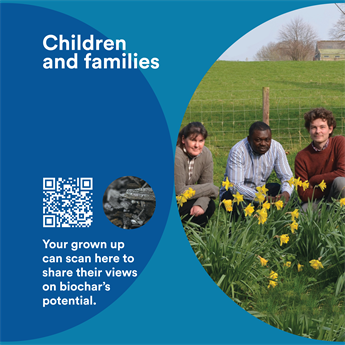Listen by the Lake
In August 2021, the Institute installed four listening posts by the side of the lake on Highfields Park. We wanted to experiment with a different way of reaching the local community at a time when, due to the Covid-19 pandemic, much of the university's engagement with audiences happened online. The posts remained up until 2024, with regularly updated content featuring research from across our university.
These listening posts allowed children and families to engage through sound and gain an insight into our world of research while enjoying outdoor recreation.
The content of the posts was updated regularly and this page serves as a record of tracks featured.
We hope you enjoy the tracks and they inspire you to carry out your own investigation!
Our last installation
This series was all about sustainability, with three very different academics explaining how the environment influences their work.

Can a buttercup be a musical instrument?
Duncan MacLeod
Listen to this recording to learn more about how the nature we see and experience all around us can inspire and even create pieces of music.

Can a spider’s web provide poetic inspiration?
Lila Matsumoto
Listen to this recording to learn more about how Nottingham research is using creative writing, called eco-poetry, to raise awareness of the environment.

What is the elephant welfare project?
Lisa Yon
Listen to this recording to learn more about how Nottingham research is helping to save the lives of elephants using the latest cutting-edge technology.
Listening posts archive
Here's a look at some of the tracks we have featured previously on our listening posts.
Into the Depths with Elizabeth Kelly
In this series, Elizabeth Kelly from the Department of Music explains what it means to research music, taking her listeners on an exploration of the unusual sounds of the contrabass clarinet.
In the first clip, Elizabeth introduces her research, particularly her opera called 'Losing Her Voice' and how the audience were invited to participate in the performance:
Listen to the full Into the Depths recording
In the three clips below, Elizabeth introduces listeners to her composition 'Into the Depths' and explains how and why she composed it, and how the unusual sounds are made.
Into the Depths analysis: part 1
Into the Depths analysis: part 2
Into the Depths analysis: part 3
Exploring our extraordinary world
Discover the universe with Omar Almaini
Listen to this track by Professor Omar Almaini from the School for Physics and Astronomy, in which he explores the formation and evolution of galaxies in our universe.
Find out more about the Ultra-Deep Survey project.

The hidden world of algae with Hannah Kemp
Listen to this track by Hannah Kemp from the School of Geography, in which they explain the secret fascination of algae and the essential role it plays.
Find out more about the Hidden Lives of Algae project.

The secrets of snails with Angus Davison
Listen to this track by Professor Angus Davison from the School of Life Sciences to learn how snails can help us to understand our own human bodies.
Find out more about Angus' work with snails.

Kids takeover - exploring sound
In this kids takeover special, local schoolchildren quiz University of Nottingham researchers for answers to their most pressing questions about sound and hearing, and then explore the answers through a range of fun, simple experiments in these short clips.
- How can playing with spoons help us to better understand the science of sounds?
- Why does sound travel better through a cardboard tube?
- Can sound waves make things move?
- How do we hear things?
Find out the answers to all these questions and many more through the clips below!
Exploring sound
Exploring sound through spoons
Sound experiments! How to create...
Learn more about sound
Secrets of the natural world
Insect defences with Christopher Taylor
In this track, Christopher introduces his research and explains how different insects defend themselves, why this is important, and what to look out for in the secret world of insects.
Find out more on Christopher Taylor's website.

The secrets of hoverflies with Christopher Taylor
Learn about the vital role played by insects, including hoverflies, in pollinating plants, as well as the significance of insects' colour, how looks can be deceiving and some tips to identify hoverflies!
Find out more on Christopher Taylor's website.

What is biochar?
Listen to this track by Tom, Clement and Catherine from the Biochar Demonstrator team to learn what biochar is and why Nottingham researchers think it can help to combat climate change.
Take part in the survey.
